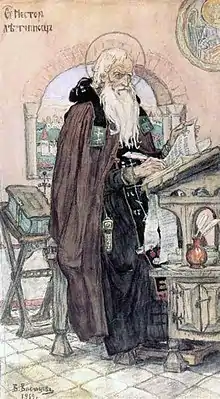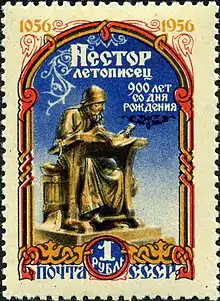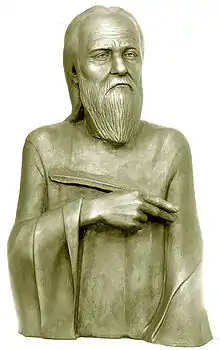Nestor the Chronicler
Nestor the Chronicler or Nestor the Hagiographer[1] (c. 1056 – c. 1114) was a monk from Kievan Rus' who is known to have written two saints lives,[1] namely the Life of the Venerable Theodosius of the Kiev Caves and the Account about the Life and Martyrdom of the Blessed Passion Bearers Boris and Gleb.[2]
Nestor the Chronicler | |
|---|---|
 Iconographic depiction of St. Nestor the Chronicler, 1919, Viktor Vasnetsov (St Volodymyr's Cathedral, Kyiv). | |
| Born | c. 1056 Kiev, Kievan Rus’ |
| Died | c. 1114 |
Traditional historiography has also assumed him to have been the author of the Primary Chronicle (PVL), the most revered chronicle of Kievan Rus', thus earning him the nickname "the Chronicler".[3][4] But several modern scholars have concluded he was not the author, because the Chronicle and known works of Nestor barely align, and frequently contradict each other in terms of style and contents.[3][4] Given the authorship controversy, some scholars prefer calling him Nestor "the Hagiographer", to be identified with the two hagiographies which they agree he did write.[4]
Biography
In 1073 AD, Nestor became a monk of the Monastery of the Caves in Kiev. The only other detail of his life that is reliably known is that he was commissioned with two other monks to find the relics of St. Theodosius of Kiev, a mission which he fulfilled successfully.
Nestor died around 1114 and was buried in the Near Caves. He has been glorified (canonized) as a saint by the Eastern Orthodox Church. The body of St. Nestor may be seen among the relics preserved in the Kiev Pechersk Lavra. His feast day is celebrated on October 27. He is also commemorated in common with other saints of the Kiev Caves Lavra on September 28 (Synaxis of the Venerable Fathers of the Kiev Caves) and on the Second Sunday of Great Lent.
Purported authorship of the Primary Chronicle
Tradition long regarded the original compilation as the work of a monk named Nestor (c. 1056 – c. 1114), who is known to have written other works at the time, such as Life of the Venerable Theodosius.[2] Hence, writers spoke of the Chronicle of Nestor,[5] and of the author as Nestor "the Chronicler". Based on the 1661 Paterik of the Kyiv Monastery of the Caves, 17th-century writers started to assert that Nestor "the Chronicler" wrote many of the surviving Rus' chronicles,[6] including the Primary Chronicle, the Kievan Chronicle and the Galician–Volhynian Chronicle,[7] even though many of the events described therein were situated in the entire 12th and 13th century (long after Nestor's death c. 1114).[7] Another reason given for belief in Nestorian authorship has been the word нестера in the opening lines of the Khlebnikov Codex (discovered in 1809[8]), which some readers took to refer to Nestor "the Chronicler",[9][10] but Ostrowski (1981) pointed out: 'The word нестера was added in [the Khlebnikov Codex], and thus cannot be used as evidence for the name of the compiler of the PVL.[10] It is not found in any of the other five main witnesses of the PVL,[10][lower-alpha 1] and thus represents an interpolation inserted into the text by an editor, who perhaps guessed the author's name.[13] From the 1830s to around 1900, there was fierce academic debate about Nestor's authorship, but the question remained unresolved, and belief in Nestorian authorship had persisted.[14] It is especially the internal evidence of the PVL and the known works of Nestor, which frequently contradict each other, while the contents barely coincide in places where that would have been expected, that has led modern scholars to conclude Nestor was not the author.[3][lower-alpha 2]
A more likely candidate as author is Sylvester of Kiev, hegumen (abbot) of the St. Michael's Monastery in Vydubychi (a village near Kyiv), who may have compiled several sources in the year 1116.[16] This attribution is based on the fact that the Laurentian text ends on page 286, lines 1 to 7, with the colophon "I wrote down (napisakh) this chronicle",[16][lower-alpha 3] after which he requests the readers to remember him in their prayers.[16] Alternately, the real author may have been some other unnamed monk from the Kyiv Monastery of the Caves mentioned in the title, and that Sylvester completed his work, or was a very early editor or copyist of the PVL.[16]Veneration

Nestor the Chronicler was canonized by including his name in the Synaxis of all Venerable Fathers of the Kiev Caves.[18]
Feast Day
- 27 October – main commemoration, (with: Nestor of Thessaloniki and Nestor of the Far Kiev Caves)
Fixed Feast Day (Synaxes)
- 25 May – Synaxis of Saints of Volhynia (ROCOR and Greek Orthodox Church)
- 15 July – Synaxis of All Saints of Kiev (ROC)
- 28 September – Synaxis of the Venerable Fathers of the Kiev Near Caves
- 10 October – Synaxis of Saints of Volhynia (ROC)
- 27 October – Synaxis of All Saints of Kiev Theological Academy and Kiev Theological Seminary [Ukrainian Orthodox Church (Moscow Patriarchate)]
Moveable Feast Day (Synaxes)
- Synaxis of all Venerable Fathers of the Kiev Caves – movable holiday on the 2nd Sunday of the Great Lent
- Synaxis of the Saints of the Kievan Caves Monastery, venerated in the near caves of Venerable Anthony – movable holiday on the 1st Saturday after Leavetaking of the Elevation of the Cross (21 September)[19]
Liturgical hymns

Troparion St. Nestor — Tone 4
Вели́ких князе́й ру́сских дея́ния/ и преподо́бных оте́ц Пече́рских жития́ и чудеса́ написа́вый,/ свое́ же, Богому́дре Не́сторе, мно́гих ти ра́ди доброде́телей и́мя/ напи́сано на Небеси́ стяжа́вый,// моли́ и нам написа́тися в Кни́ги Живо́тныя.
Velikikh knyazey russkikh deyaniya/ i prepodobnykh otets Pecherskikh zhitiya i chudesa napisavy,/ svoe zhe, Bogomudre Nestore, mnogikh ti radi dobrodeteley imya/ napisano na Nebesi styazhavy,// moli i nam napisatisya v Knigi Zhivotnyya.
Common Troparion St. Nestor — Tone 4
Времена́ и ле́та достопа́мятных дея́ний,/ по́двиги и труды́ Богоно́сных оте́ц,/ Не́сторе прему́дре, напису́я,/ любо́вию возгоре́лся еси́ после́довати стопа́м первонача́льных,/ с ни́миже не преста́й моли́тися Христу́ Бо́гу,// спасти́ся душа́м на́шим.
Vremena i leta dostopamyatnykh deyany,/ podvigi i trudy Bogonosnykh otets,/ Nestore premudre, napisuya,/ lyuboviyu vozgorelsya esi posledovati stopam pervonachalnykh,/ s nimizhe ne prestay molitisya Khristu Bogu,// spastisya dusham nashim.
Kontakion St. Nestor — Tone 2
Я́ко сый Богоно́снаго Феодо́сия учени́к/ и и́стинный жития́ того́ подража́тель,/ пе́рвый честны́х его́ моще́й самови́дец бы́ти сподо́бился еси́,/ я́же с про́чиими святоле́пно прене́с,/ насле́дил еси́ с те́миже Ца́рство Небе́сное,// е́же получи́ти и нам, чту́щим тя, Го́сподеви моли́ся.
Yako siy Bogonosnago Feodosiya uchenik/ i istinny zhitiya togo podrazhatel,/ pervy chestnykh ego moshchey samovidets byti spodobilsya esi,/ yazhe s prochiimi svyatolepno prenes,/ nasledil esi s temizhe Tsarstvo Nebesnoe,// ezhe poluchiti i nam, chtushchim tya, Gospodevi molisya.
Known works
- Life of the Venerable Theodosius of the Kiev Caves (1080s)[20]
- Account about the Life and Martyrdom of the Blessed Passion Bearers Boris and Gleb (1080s)[21]
- (disputed) Primary Chronicle, or The Tale of Bygone Years (ca. 1113)
Notes
- The often careless writer Vasily Tatishchev (1686–1750) claimed that three Chronicle texts that were somehow "lost" later also identified "Nestor" as the author.[9] Modern scholars distrust all such "Tatishchev information" until it is supported by another extant source.[11][12]
- 'In any case, the internal evidence of the Povest', along with the lack of coincidence of its contents with Nestor's works wherever the two are related, is distinctly opposed to the tradition of Nestorian authorship.'[15]
- Church Slavonic: Игуменъ силивестръ стаг михаила· написах книгы си лѣтописець·, romanized: Igumenʺ silivestrʺ stag mikhaila· napisakh knigy si lětopisecʹ·, lit. 'Abbot Silivestr" of St. Michael's Abbey – I wrote this chronicle [lit. "book of year writings"].[17]'
References
- Plokhy 2006, p. 19.
- Cross & Sherbowitz-Wetzor 1953, p. 6.
- Cross & Sherbowitz-Wetzor 1953, pp. 6–12.
- Plokhy 2006, pp. 19–20.
- Cross & Sherbowitz-Wetzor 1953, p. 3.
- Tolochko 2007, p. 31.
- Tolochko 2007, p. 47.
- Maiorov 2018, p. 339.
- Cross & Sherbowitz-Wetzor 1953, p. 17.
- Ostrowski 1981, p. 28.
- Tolochko 2005, pp. 458–468.
- Ostrowski 2018, pp. 36, 38, 47.
- Ostrowski 2003, pp. xvii–xviii.
- Tolochko 2007, pp. 32–33.
- Cross & Sherbowitz-Wetzor 1953, p. 12.
- Ostrowski 2003, p. xvii.
- Ostrowski & Birnbaum 2014, 286.1–2.
- "НЕСТОР". www.pravenc.ru. Retrieved 2022-07-25.
- "СОБОР ПРЕПОДОБНЫХ ОТЦОВ КИЕВО-ПЕЧЕРСКИХ БЛИЖНИХ ПЕЩЕР - Древо". drevo-info.ru (in Russian). Retrieved 2022-07-25.
- "Saint Nestor the Chronicler" (PDF). St. Luke Greek Orthodox Church. Retrieved 19 March 2017.
- "Venerable Nestor the Chronicler of the Kiev Caves". Orthodox Church in America. Retrieved 19 March 2017.
Bibliography
- This article incorporates text from a publication now in the public domain: Chisholm, Hugh, ed. (1911). "Nestor (author)". Encyclopædia Britannica. Vol. 19 (11th ed.). Cambridge University Press. p. 406, 407.
- Cross, Samuel Hazzard; Sherbowitz-Wetzor, Olgerd P. (1953). The Russian Primary Chronicle, Laurentian Text. Translated and edited by Samuel Hazzard Cross and Olgerd P. Sherbowitz-Wetzor (PDF). Cambridge, Massachusetts: The Mediaeval Academy of America. p. 325. Retrieved 26 January 2023. (First edition published in 1930. The first 50 pages are a scholarly introduction.)
- Maiorov, Alexander V. (November 2018). ""I Would Sacrifice Myself for my Academy and its Glory!" August Ludwig von Schlözer and the Discovery of the Hypatian Chronicle". Russian History. Brill. 45 (4): 319–340. Retrieved 19 May 2023.
- Ostrowski, Donald (March 1981). "Textual Criticism and the Povest' vremennykh let: Some Theoretical Considerations". Harvard Ukrainian Studies. Harvard Ukrainian Research Institute. 5 (1): 11–31. Retrieved 6 May 2023.
- Ostrowski, Donald, ed. (2003). The Povest' vremennykh let: An Interlinear Collation and Paradosis. 3 volumes (in Russian and English). Cambridge, MA: Harvard University Press. Archived from the original on 2005-03-09. Retrieved 2002-03-23. (assoc. ed. David J. Birnbaum (Harvard Library of Early Ukrainian Literature, vol. 10, parts 1–3) – This 2003 Ostrowski et al. edition includes an interlinear collation including the five main manuscript witnesses, as well as a new paradosis ("a proposed best reading").
- Ostrowski, Donald; Birnbaum, David J. (7 December 2014). "Rus' primary chronicle critical edition – Interlinear line-level collation". pvl.obdurodon.org (in Church Slavic). Retrieved 17 May 2023. – A 2014 improved digitised version of the 2002/2003 Ostrowski et al. edition.
- Ostrowski, Donald (2018). "Was There a Riurikid Dynasty in Early Rus'?". Canadian-American Slavic Studies. 52 (1): 30–49. doi:10.1163/22102396-05201009.
- Plokhy, Serhii (2006). The Origins of the Slavic Nations: Premodern Identities in Russia, Ukraine, and Belarus (PDF). New York: Cambridge University Press. pp. 10–15. ISBN 978-0-521-86403-9. Archived (PDF) from the original on 6 June 2011. Retrieved 27 April 2010.
- Tolochko, Oleksiy (2005). "История Российская" Василия Татищева: источники и известия "Istoriia Rossiiskaia" Vasiliia Tatishcheva: istochniki i izvestiia [Vasily Tatishchev's "History of Russia": Sources and Information]. Moscow: Новое литературное обозрение Novoe literaturnoe obozrenie. p. 543. ISBN 9795867933462. Retrieved 17 May 2023. (also published at Kritika, Kyiv, 2005)
- Tolochko, Oleksiy (2007). "On "Nestor the Chronicler"". Harvard Ukrainian Studies. Harvard University. 29 (1): 31–59. Retrieved 30 September 2022.
External links
 Media related to Nestor the Chronicler at Wikimedia Commons
Media related to Nestor the Chronicler at Wikimedia Commons- Venerable Nestor the Chronicler of the Kiev Near Caves Orthodox icon and synaxarion
- Visitor information for Kyiv Pechersk Lavra